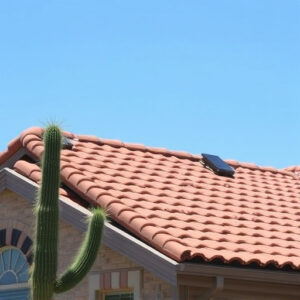In Oro Valley, homeowners choose between traditional asphalt shingles, metal alternatives, clay/concrete tiles, and green roofing for diverse needs. Cost, durability, energy efficiency, maintenance, aesthetic appeal, environmental impact, and local regulations are key considerations. Metal roofing excels in durability, fire resistance, and energy savings; while green practices offer long-term savings with eco-friendly materials. Proper inspections and regular maintenance are vital for all choices to ensure optimal performance and prevent costly repairs.
When it comes to roofing in Oro Valley, choosing the right material is a significant decision. This comprehensive guide explores various roofing options, comparing durability, energy efficiency, cost, maintenance, aesthetics, environmental impact, lifespan, and performance in extreme weather. From traditional asphalt shingles to modern metal roofs, and from clay tiles to innovative membrane systems, we break down the pros and cons to help you select the ideal roofing material for your Oro Valley home.
- Oro Valley Roofing: Asphalt Shingles vs Metal
- Durability Comparison: Clay Tile vs Concrete
- Energy Efficiency: Flat Roofs vs Inclined
- Cost Analysis: Wood Shake vs Composition
- Maintenance Considerations: Slate vs Fiberglass
- Esthetic Appeal: Ceramic vs Vinyl
- Environmental Impact: Natural vs Synthetic
- Lifespan Evaluation: Membrane vs Traditional
- Performance in Extreme Weather: Metal vs Shingles
- Local Regulations: Choosing the Right Roofing Material
Oro Valley Roofing: Asphalt Shingles vs Metal
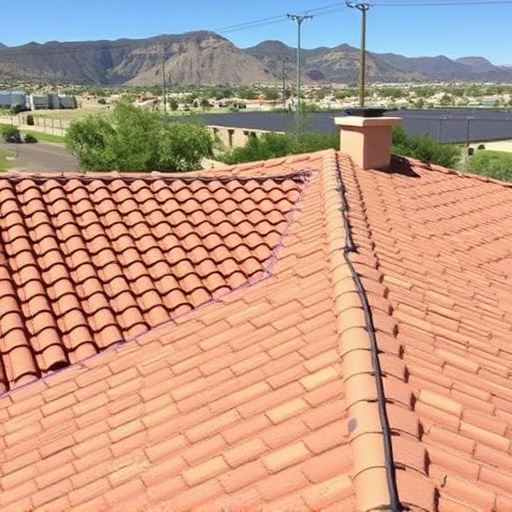
In Oro Valley, when considering roofing materials, homeowners often find themselves pitted between traditional asphalt shingles and modern metal alternatives. Both have their strengths; however, understanding their distinct features is crucial for making an informed decision that not only suits aesthetic preferences but also offers robust protection against Arizona’s varied weather conditions.
Asphalt shingle roofing in Oro Valley has long been a popular choice due to its affordability and ease of installation. These shingles are versatile, suitable for pitched roofs and offer a wide range of colors and styles. Moreover, they effectively shield homes from sun, snow, and rain, with proper underlayment and ventilation. On the other hand, metal roofing practices in Oro Valley gain traction for their exceptional durability and longevity. Metal panels can withstand extreme temperatures, high winds, and even fire, making them a wise investment for homeowners looking to safeguard their properties. Additionally, green roofing practices, which integrate eco-friendly materials, are increasingly popular, offering not just environmental benefits but also improved energy efficiency through better heat reflection. Early detection of roof leaks through regular inspections is paramount, regardless of the chosen material, as it can prevent severe damage and costly repairs.
Durability Comparison: Clay Tile vs Concrete
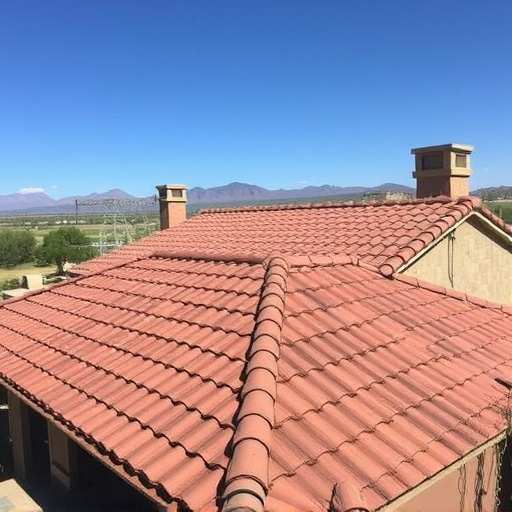
When it comes to durability, clay tiles and concrete are both top contenders for roofing materials in Oro Valley. Clay tiles have a long-standing reputation for their resilience against extreme weather conditions, including heavy rain, strong winds, and even some level of frost. They are known to last between 30 to 40 years, sometimes even longer with proper maintenance. This makes them a cost-effective choice for homeowners in the long run, as they require minimal replacement.
On the other hand, concrete roofs have emerged as a modern alternative, offering superior durability and strength. They are designed to withstand heavy loads and extreme temperatures, making them an excellent option for regions like Oro Valley where natural disasters can occur. Concrete is highly resistant to fire, rot, and mold, ensuring a longer lifespan compared to clay tiles. Moreover, with proper installation, concrete roofs can last for several decades, outperforming many other roofing materials available in the current roofing trends of Oro Valley. This makes them a popular choice among both homeowners and professional roofers, especially when it comes to emergency roof repair in Oro Valley.
Energy Efficiency: Flat Roofs vs Inclined
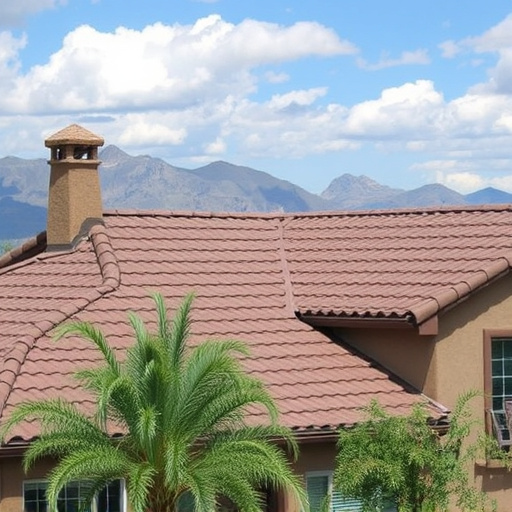
When comparing energy efficiency between flat roofs and inclined roofs, it’s evident that the latter offers a significant advantage. Inclined roofs are designed to shed water effectively, but they also provide better insulation. This is because the slope allows for more space to install insulating materials, reducing heat transfer between the indoor environment and the exterior. As a result, homes with sloped roofs tend to maintain consistent temperatures year-round, leading to lower energy consumption for heating and cooling.
In contrast, flat roofs, while efficient in some aspects like reduced material costs, often lack adequate insulation. In Oro Valley, where extreme weather conditions can include hot summers and cold winters, inadequate insulation on a flat roof could result in significant energy losses. Commercial roofing solutions in Oro Valley that prioritize energy efficiency, such as those involving high-performance insulation or reflective coatings, can make inclined roofs even more beneficial for both residential and commercial properties, ensuring comfort while minimizing utility bills. Consider obtaining roofing estimates in Oro Valley to explore these efficient options further.
Cost Analysis: Wood Shake vs Composition
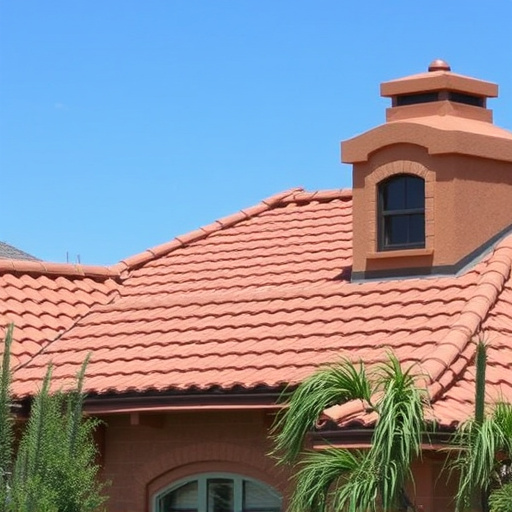
When comparing roofing materials, the initial consideration often revolves around cost. Among commonly debated options in Oro Valley are wood shakes and composition shingles. Wood shake roofs have long been a popular choice for their aesthetic appeal, offering a distinct, natural look that enhances the curb appeal of homes. However, they are significantly more expensive than composition shingles, which are an eco-friendly roofing option known for their durability and lower upfront cost.
In terms of roofing estimates Oro Valley, wood shakes often come with a premium due to their labor-intensive installation process and the need for regular maintenance. On the other hand, composition shingles, favored by many as part of sustainable roofing practices in Oro Valley, require less frequent replacement and are more readily available. For homeowners looking for long-term savings and reliable performance, composition shingles stand out as a practical choice. They also offer various styles to mimic the look of wood shakes without the high cost or maintenance concerns, making them a preferred option among roof replacement specialists Oro Valley.
Maintenance Considerations: Slate vs Fiberglass
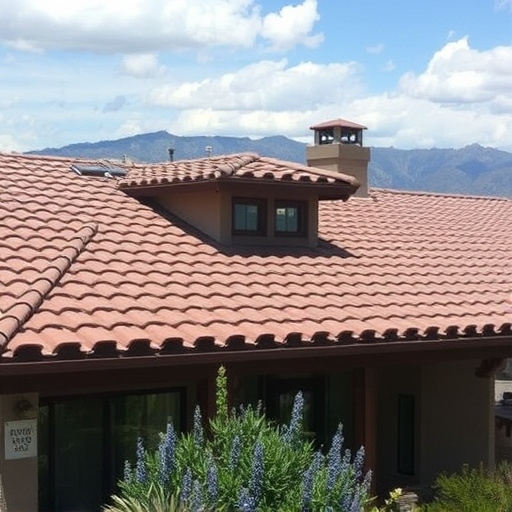
When comparing roofing materials like slate and fiberglass for your Oro Valley home, maintenance considerations are crucial. Slate roofs, while beautiful and durable, require more meticulous care. They’re prone to cracking if not installed properly and need periodic re-sealing to maintain their water-resistant properties. Regular inspections are essential to catch any cracks early, as they can lead to costly repairs or even roof leaks in Oro Valley.
On the other hand, fiberglass roofing offers a low-maintenance alternative. These shingles are resistant to rot, corrosion, and mold, reducing the likelihood of hidden damage that could compromise your roof’s integrity. With proper installation, they require minimal upkeep beyond occasional cleaning to keep them looking their best. Additionally, many fiberglass shingles come with extensive warranties and guarantees in Oro Valley, offering peace of mind and safeguarding against unexpected costs associated with repairs or replacements due to manufacturer defects.
Esthetic Appeal: Ceramic vs Vinyl
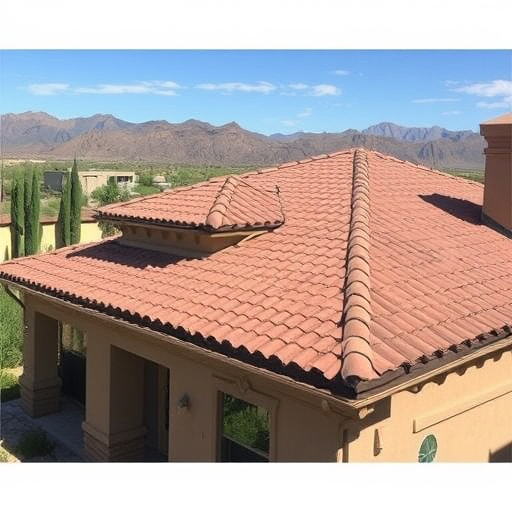
When it comes to enhancing the aesthetic appeal of your Oro Valley home, choosing the right roofing material is essential. Ceramic roofs offer a timeless and elegant look with their durable clay or stone composition, available in various styles and colors. This option provides a sophisticated touch, especially for traditional or Mediterranean-inspired designs. On the other hand, vinyl roofing has gained popularity due to its affordability and versatility. Vinyl shingles come in numerous colors and imitations of natural materials like wood or slate, making it an attractive choice for those seeking a cost-effective yet visually appealing upgrade in Oro Valley.
Consider incorporating green roofing practices into your Oro Valley home’s design to further boost its appeal. While ceramic roofs may have a higher upfront cost, their longevity and ability to withstand harsh climates make them a sound investment. Vinyl, being more budget-friendly, is ideal for those looking for affordable roofing services in Oro Valley without compromising on style. Additionally, regular roofing maintenance tips can help extend the life of any material, ensuring your Oro Valley home’s roof remains a stunning feature for years to come.
Environmental Impact: Natural vs Synthetic
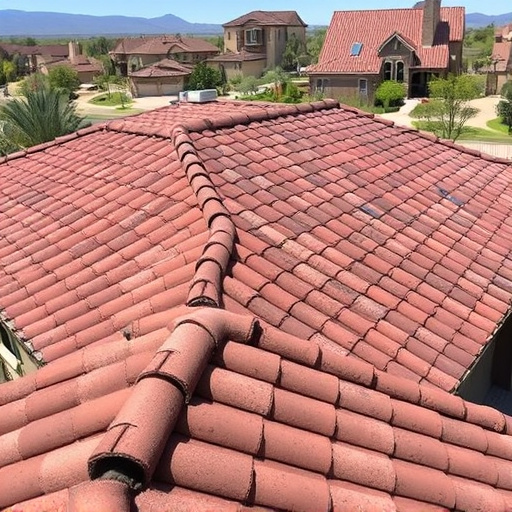
When considering roofing materials for your Oro Valley home, one crucial aspect to evaluate is their environmental impact—a key differentiator between natural and synthetic options. Natural roofing materials, such as shingles made from organic compounds like cedar or asphalt shingles derived from petroleum, have a distinct ecological footprint. These materials contribute to local waste streams and can take a significant amount of energy to produce and transport. Moreover, certain natural substances may contain chemicals that can impact air quality.
On the other hand, synthetic roofing options are designed with sustainability in mind. Materials like TPO (thermoplastic olefin) or PVC (polyvinyl chloride) offer exceptional durability while minimizing environmental harm. These synthetic alternatives often have longer lifespans, reducing the need for frequent replacements, and their production processes typically result in lower greenhouse gas emissions compared to traditional natural materials. For residents of Oro Valley seeking both reliable roofing solutions and eco-friendly options, considering these synthetic materials could be a smart choice, even when considering potential emergency roof repair needs or requiring affordable roofing services from nearby companies.
Lifespan Evaluation: Membrane vs Traditional
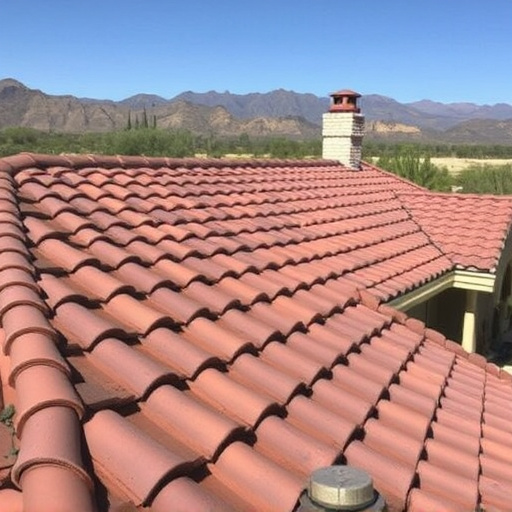
When it comes to evaluating the lifespan of roofing materials, there’s a significant contrast between traditional methods and innovative options like membrane systems. In Oro Valley, where residential and commercial flat roof installations are common, understanding this distinction is crucial for long-term protection. Traditional roofing materials, such as tiles or shingles, typically offer a lifespan ranging from 20 to 30 years with proper maintenance. However, they are susceptible to damage from extreme weather conditions, requiring frequent repairs and replacements over time.
In contrast, membrane roofing systems have gained popularity due to their exceptional longevity. These modern materials can last for 50 years or more under optimal circumstances, making them a preferred choice for both residential and commercial properties in Oro Valley. Compared to tile roofing systems, which may need replacement after significant weather events, flat roof membranes provide better protection against leaks and offer easier maintenance. For businesses seeking reliable commercial flat roof repair solutions, membrane technology ensures cost-effectiveness and reduced downtime over the long term.
Performance in Extreme Weather: Metal vs Shingles
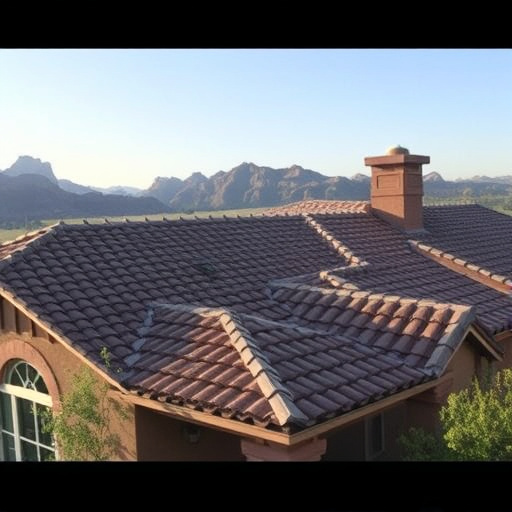
When it comes to performance in extreme weather conditions, metal roofing stands out against traditional shingles for several reasons relevant to homeowners in Oro Valley. In terms of durability, metal is superior; it can withstand high winds and intense storms better than shingles, reducing the risk of damage during severe weather events common in this region. Additionally, metal roofs offer superior reflectivity, helping to keep homes cooler in summer heat and potentially reducing energy costs for residents in the residential roofing Oro Valley market.
Beyond these benefits, metal roofing also provides enhanced safety procedures in terms of fire resistance. Its non-combustible nature makes it a safer choice compared to shingles, which can easily catch fire during dry spells. Moreover, the longevity of metal roofs means less frequent repairs and replacement, saving homeowners money on roofing leak detection and repair services in Oro Valley. This long lifespan also contributes to sustainability, as metal roofing materials can be recycled, making them an eco-friendly option for those concerned about environmental impact.
Local Regulations: Choosing the Right Roofing Material
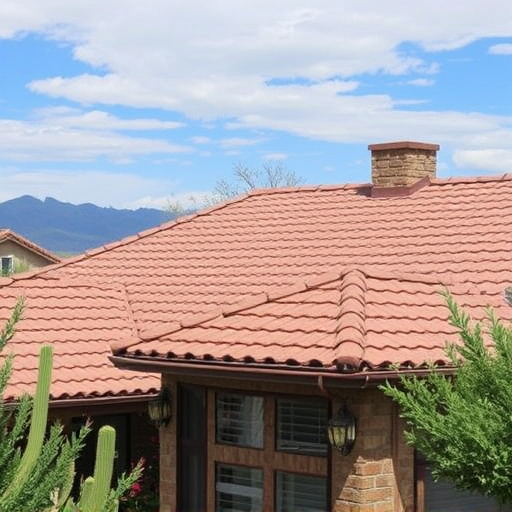
When selecting a roofing material for your Oro Valley property, it’s crucial to consider local regulations that often dictate what types of roofs are permitted in specific neighborhoods. These guidelines exist for several reasons, including safety, structural integrity, and aesthetic consistency within communities. For instance, some areas may have restrictions on the slope of roofs to prevent flooding or require specific materials that can withstand extreme weather conditions prevalent in Oro Valley.
For commercial roofing solutions in Oro Valley, property owners and managers must adhere to these regulations while also choosing materials that offer durability, cost-effectiveness, and low maintenance. Tile roofing systems, for example, are popular choices due to their longevity and attractive designs. Conversely, flat roofs may be more suitable for certain structures but require specialized commercial flat roof repair techniques to ensure water-tight integrity.
When considering roofing materials for your Oro Valley property, it’s clear that each option offers unique benefits and drawbacks. From durability and energy efficiency to cost and maintenance, the choice is vast. Asphalt shingles and metal excel in performance during extreme weather, while clay tiles and concrete provide exceptional longevity. Flat roofs are energy-efficient but require more maintenance. Wood shakes offer a natural aesthetic but come with higher costs. Slate and fiberglass have distinct visual appeals yet differ in durability. Choosing the right roofing material involves balancing these factors with local regulations. Ultimately, the best option aligns with your preferences, budget, and climate while ensuring a roof that stands the test of time.
